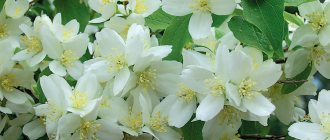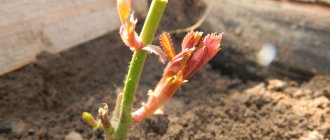Mock orange Virgin, or maiden, is a deciduous ornamental shrub that is considered one of the most attractive of all varieties of garden jasmine. It has good endurance, is easy to care for, and shows excellent growth rates. In the summer, Virginal blooms with beautiful snow-white buds, which delight everyone around.
Mock orange is immune to atmospheric pollution and can grow within the city.
Description of the Virgin jasmine variety and characteristics
Chubushnik Virgin, a description and photo of which are presented below, is a beautiful shrub that grows up to 3 m in height and 2.5-3 m in width. The plant is spreading, with straight branches and a lush crown. Its leaves are quite large, with short petioles of simple structure and slightly oval shape. Their length is approximately 6-7 cm. The foliage has slight pubescence on the inside and is smooth on the outside. The color of the crown is juicy, dark green during the growing season and flowering (late spring, summer) and yellow closer to autumn.
Virgin blooms with snow-white or slightly yellowish, large, loose buds up to 5 cm in diameter. They have a strong and persistent aroma, similar to orange combined with vanilla. The calyxes of the flowers are of a goblet-type structure and contain 4-5 concave sepals. Corollas with large petals from four to six pieces, which can overlap each other or be at intervals. In total, 8-10 flowers are collected in inflorescences. The budding period for Virgin is about a month, lasting from the end of June to the last days of July. After the mock orange fades, fruits appear in place of the buds - boxes with nests filled with small seeds. The variety shows rapid growth rates, annually adding 25 cm in height, and with regular care even more.
Warning! One year, Virginal buds may be double, and the next season they may have simple petals.
Verginsky mock orange is highly resistant to frost and can be grown in central Russia. It is noted that even if the branches freeze, the plant quickly recovers, and this fact is not reflected in its appearance. The shrub is quite unpretentious and requires basic care. The Virgin mock orange is moderately resistant to diseases, but can often be attacked by various harmful insects.
Growing rules
The rules for growing the Virgin mock orange variety are the most standard: for full development, the bush needs timely watering, 2-3 feedings per season and good shelter for the winter. If desired, garden jasmine is mulched, the soil is loosened and the ground around it is weeded.
Watering schedule
Garden jasmine of the Virgin variety develops best in moderately moist soils, so it is important to observe regular watering and a number of basic rules associated with this process:
- For watering Virgin mock orange, only water that has stood in the sun is suitable. Cold water cannot be used; it must warm up at least a little.
- Garden jasmine is watered about 2 times a week if the year is moderately hot. During the dry season, the frequency is increased to 3 times a week. If the season promises to be rainy, watering can be reduced to once a week. In case of particularly heavy rainfall it is stopped altogether. During the mock orange flowering period, it is watered every day.
- Each time after watering, it is recommended to slightly loosen the soil under the garden jasmine and renew the mulch layer.
Important! Each bush requires an average of 1-2 buckets of water; the plantings should not be flooded. Stagnant moisture is detrimental to mock orange roots.
Weeding, loosening, mulching
Loosening the soil is necessary in order to improve air permeability. It is especially important to carry out this procedure if, after watering or rain, the top layer of soil has become compacted and began to resemble a crust.
Mulching is carried out immediately after planting, using peat, sawdust or pine needles. This is done so that moisture remains in the soil longer after watering.
Weeding the soil is carried out as necessary if too many weeds grow under the bush. A small growth does not cause much harm to the mock orange.
Important! If you cover the trunk circle of garden jasmine with a layer of mulch, the need for weeding disappears by itself. Weeds usually do not grow through mulch material.
Feeding schedule
The Virgin mock orange variety is fed only in the second year after planting in open ground. It is better not to apply fertilizers before this - they can cause burns to the root system of young, immature seedlings. On average, 2-3 feedings are applied per season.
In the spring, mock orange can be fed with organic fertilizers, and both mulching the tree trunk circle and fertilizing the soil are suitable.
The bush is fed the second time during the formation of buds. At this time, complex mineral fertilizers are used.
In the fall, organic matter is again used as fertilizing. This way, the mock orange will receive enough nutrients to survive the winter safely. If desired, instead of organic fertilizers, you can use phosphorus-potassium mixtures.
Trimming
In order for the bush to remain attractive and maintain its decorative appearance, it needs to be pruned from time to time. They do this in spring and autumn.
In the spring months, mock orange is examined immediately after the shelter is removed for the winter. All frozen or broken shoots are removed from the bush and branches that have strayed from the crown are slightly shortened.
In the fall, after flowering, all faded inflorescences should be removed from the Virgin mock orange. Additionally, it is necessary to thin out the shrub, since thickening the crown negatively affects its development - the leaves deep in the crown receive insufficient light, so the plant begins to weaken.
Advice! You can achieve more luxuriant flowering if you cut garden jasmine “to the stump” in August - shorten 2-3 old shoots to their maximum length.
Preparing for winter
Garden jasmine Virginal is required to be covered in the north of the country and the middle zone, especially young plants. Mature plants are not so vulnerable to low temperatures. In the south of Russia, you don’t have to insulate mock orange trees at all before winter.
Preparing a shrub for wintering involves the following steps:
- The area under the bush is mulched with peat or any other suitable material.
- Then the mock orange branches are carefully tied up and the bush is wrapped in agrofibre.
- When precipitation begins to fall, the snow is raked up to the bush, using it as additional shelter from the wind and cold.
Important! With the onset of constant warmth in spring, the shelter is removed without delay. If you keep the bush under cover for too long, it may burst.
Advantages and disadvantages of the variety
Since the Virgin mock orange has a long history, gardeners have managed to learn a lot of interesting things about it. Everyone identifies for themselves a number of pros and cons of the plant.
Mock orange Virgin does not always bloom with fragrant buds; there are also weak-smelling varieties
Advantages:
- abundant flowering;
- pleasant aroma;
- decorativeness;
- ease of care;
- long lifespan.
Flaws:
- susceptibility to insect attacks;
- requirement for watering.
How to care?
Virgin mock orange needs:
- systematic watering;
- 2-3 feedings during the season;
- systematic shelter before the start of winter.
Mulching, loosening and weeding of the earth are carried out as needed. It is allowed to use only water that has been left in the sun for irrigation. Watering is carried out twice a week if the weather is not too hot.
The usual water consumption per bush is 10-20 liters. Weed the ground only when a large number of weeds appear. If there are few of them, there is no risk for mock orange. Mulching allows you to almost eliminate the need for weeding. Feeding is needed only in the second year of development in open ground.
Excessively early application of fertilizers often leads to burns of the root system. Usually 2 or 3 feedings are carried out per season. In spring, organic fertilizers are used. They are applied in two ways: either by mulching the tree trunk circle, or by placing the necessary substances in the ground. The second feeding is needed when the buds are setting, and at this moment complex mineral compositions are needed.
With the onset of autumn, organic feeding is carried out again. It allows you to guarantee a successful wintering. Please note: organic matter can be replaced with phosphorus-potassium compounds. At the beginning and end of the growing season, pruning is carried out to maintain the external attractiveness of the bush. In autumn, the bushes are thinned out to avoid thickening the crown and weakening the plants.
Infusions and decoctions will help fight harmful insects:
- wormwood;
- tansy;
- dandelion;
- yarrow;
- marigolds.
To learn how to grow maiden mock orange, see the following video.
Reproduction methods
Mock orange Virgin is most often propagated vegetatively. To do this, they use the methods of division, cuttings and layering. The last option is considered the easiest. It is performed according to the following scheme:
- In the spring, they select a healthy shoot from the bush and bend it to the surface of the earth.
- Secure the branch with a pin and sprinkle it with soil.
- With the arrival of autumn, the shoot is dug up and planted in a permanent place.
The cutting method is also quite often used by gardeners. Green Virginal cuttings with a segment of last year's growth and two pairs of leaves are cut off at the beginning of summer, buried in sandy, loose soil and covered with cellophane. After a couple of weeks, the bag is removed, the cuttings are cared for until spring, and with the arrival of stable warmth, they are planted.
The division method most often becomes forced and is used when the plant gets old. The bush is dug up and divided into 3-4 parts so that each has roots.
Mock orange Virgin is very difficult to propagate by seed.
Planting a plant
Planting begins with the acquisition of a seedling.
Additional Information! To purchase a healthy plant that will have a sufficient level of viability, you should contact specialized outlets that sell seedlings or nurseries. You should take a closer look at the roots and existing buds. They must be alive and healthy.
After it is purchased, you need to prepare the planting site. A sufficiently illuminated area is best suited - this is the place that will allow the plant to develop well, bloom intensively and produce abundant greenery.
In the absence of such a place, you can choose a slightly shaded area.
Planting from seeds
If you want to plant virgin mock orange by sowing seeds in the ground, you should pay attention to the fact that the seeds should be planted in cups. It is necessary to grow seedlings and only then, upon reaching a certain size, transplant them to a permanent place. It is also taken into account that in this case it will be possible to see flowers only in the 5-7th year of the bush’s growth. That is why this type of planting is less popular.
Planting and caring for Virginia mock orange
Planting and caring for garden jasmine of the Veginel variety does not cause problems for summer residents. In general, it has the same requirements as other varieties of crops: watering, fertilizing, pruning. Even a beginner can cope with planting a plant.
Conditions and terms of landing
To breed the Virgin mock orange variety, the main thing is to choose the right seedling. It must have good vitality, be strong, and have a healthy root system. It is recommended to place it in a permanent place in spring or autumn, and planting material grown in containers is planted from spring to autumn.
Advice! Virgin mock orange should be planted so that it has enough time to take root before the arrival of winter.
How to plant correctly
It is better to place the Virgin mock orange in a well-lit, windless place. A slightly darkened area is also suitable, but then the buds will become smaller and lose their rich aroma. The variety prefers to grow on loose soil with good water permeability and without high groundwater levels. If the soil is too heavy, then it is dug up half a month before planting and diluted with sand.
Warning! Wet soil can negatively affect the development of Virgin mock orange.
Before preparing a planting hole for a young plant, it is recommended to pay attention to the size of its roots. On average, the depth of the pit should be 0.5 m, and its diameter 0.500.6 m.
Mock orange Virgin is planted according to the following algorithm:
- A 15-centimeter layer of drainage is laid at the bottom of the hole.
- A little garden soil mixed with sand and humus is poured on top. Additionally, you can add nitrophoska.
- Lower the seedling into the hole so that the root collar is above the soil level and cover it with soil.
- Water generously, compact and mulch to 5 cm with sawdust or compost.
If the planting is in groups, then the interval between each Virginal bush should be 2 m. If you plan to create a hedge from the plant, the distance is reduced to 1-1.5 meters.
Hybrid mock orange is attractive to honey bees
Aftercare
Although the Virgin mock orange is an unpretentious plant, its mass flowering requires certain care. Watering should be done only with warm water kept in a container. One plant needs approximately 20-30 liters. In spring, the crop is watered twice a week, in extreme heat and at the moment of budding - daily. Before moistening, the soil around is loosened. The mock orange variety Virgin is fertilized with mineral complex preparations. Typically, these fertilizers are applied during the growing season. In late autumn, it is useful to fertilize the plant with organic matter.
In addition, the Virgin mock orange needs to be pruned. In the fall, all inflorescences are removed, and if there is severe overgrowth, unhealthy and weakened branches are cut off. With the arrival of warmer weather, if some shoots of the plant are frozen, they should also be removed. Every 3-4 years, mock orange requires a rejuvenating pruning, during which the old branches are completely cut out.
Despite the fact that Virgin is a winter-hardy variety, it is advisable to prepare young bushes for cold weather. Mulch the tree trunk circle with peat or cover it with special material.
Advice! When tying the trunk with agrofibre, the branches are pre-tied, pointing upward.
In winter, during snowfall, the snow mass is brought under the mock orange. This will give additional protection to its root system.
Preparing for winter
To prepare the plant for winter, it must be wrapped in agrofibre. But this is only relevant for young bushes. This is not necessary for mature plants. If frosts in winter are still quite strong, then you can mulch the area under the bush with any suitable material or peat.
If you still plan to tie it in agrofibre, then the branches must first be tied so that they are directed vertically upward and do not tear the material.
When there is heavy precipitation in the form of snow, the snow mass must be brought under the bush. This will provide protection from freezing of the root system.
Important ! As soon as the first thaw occurs, the shelter must be removed immediately.
Winter harness
Diseases and pests
Garden jasmine of this variety has a fairly stable immunity to various diseases, which cannot be said about pests. Quite often, Virgin mock orange can be attacked by insects such as spider mites, bean aphids, and weevils. To prevent the plant from suffering from them, it is advisable to carry out preventive measures annually. Insecticides are considered the most effective remedy, but if the gardener is adamant about chemicals, then you can try to protect the mock orange with companion plants. For example, wormwood, tansy, marigold, and tomato can repel the above insects.
Advice! An infusion made from tobacco dust can effectively control pests.
Planting seedlings in open ground
It’s easier to buy rooted cuttings right away. Although they can be bred independently if you cut green twigs from the plant, approximately in the month of June.
Important! When preparing cuttings yourself, you need to cut the branch so that there are at least 2 pairs of leaves on it. Moreover, the top ones must be cut in half. And the lower ones - completely remove, but do not affect the kidney.
Another option for harvesting your own is to cut a branch in the fall. To prevent it from germinating ahead of schedule, it is stored in the refrigerator in a plastic bag.
Additional Information! The branch must be long enough, since it is cut into 5 cm sections only at the end of March.
Before burying the pipes in the ground, they must be soaked in a solution of a growth stimulator. This will allow the root system to form faster.
Application in landscape design
Virgin mock orange (Philadelphus virginal) can be very beautifully and effectively placed in the garden. Its double flowers themselves look magnificent, especially since the bush is quite massive, spreading and vigorous. It will look gorgeous on the lawn or against a brick wall. Also, Virgin mock orange will be an excellent addition to other garden crops and will add bright colors to summer gardens. The lemon-yellow bush can decorate any flowerbed and serve as a wonderful backdrop for an alpine slide. Mock orange can also be used as a border or trimmed hedge; it looks great as part of a tree and shrub composition, in a flower bed with mixed annuals.
Virginal retains its decorative qualities for 20 years
Peculiarities
Mock orange is a simple shrub that can grow both along roads and in an elegant garden. The plant is decorative during flowering and after. Some varieties are especially beautiful in the fall.
At the same time, garden jasmine can be planted as a tapeworm, making it the center of a composition or a background for herbaceous plantings. The snow-white flowering of the shrub in combination with blue, lavender and purple shades of flowers is especially appreciated. Despite the unpretentiousness of mock orange, which can grow without any care at all, the degree of its decorativeness greatly depends on the attention of the gardener.
Among the disadvantages of the crop, several difficulties in growing are mentioned:
| Problem | Causes and solution |
| The green mass is juicy and bright, but there is no flowering. | Excess organic fertilizers or nitrogen fertilizers. Stop feeding and add phosphorus-potassium mixtures. |
| Curling, drooping, drooping or falling leaves. | Dry air, excessive heat, prolonged drying out of the soil. Abundant watering and spraying of the crown is recommended. |
| Reduced bud formation and frequent fungal infections. | There may be stagnation of moisture at the roots. A drainage device or transfer of mock orange to a new location is required. |
| Jasmine quickly stops flowering. The buds are small and single. | Density of plantings, lack of pruning and cleaning of the bush, or degeneration of mock orange due to old age. Replanting and rejuvenation of plantings. |
Sometimes gardeners also note that jasmine reacts by yellowing foliage to a lack of nutrition. We can quickly eliminate this drawback by fertilizing with potassium or watering with an infusion of wood ash.
Jasmine is an amazingly beautiful and delicately scented shrub. Its planting and care are not difficult, and the flowers not only decorate the garden, but also have medicinal properties.
Aromatic tea from garden mock orange treats stomach problems, soothes, removes toxins and increases the body's immune defense. Jasmine hedges are not only a beautiful decoration, but also protection from city noise and dust.











